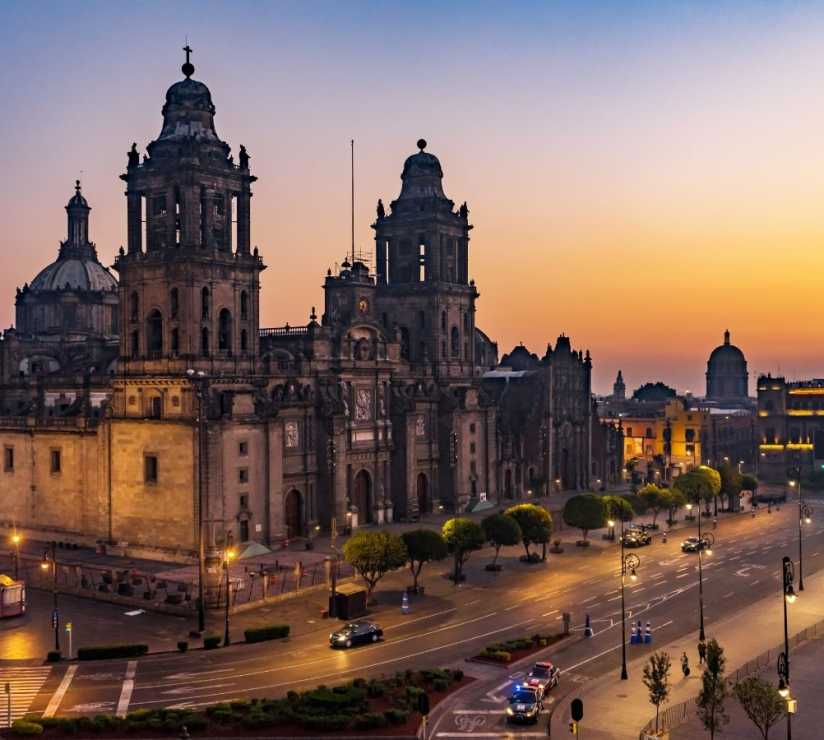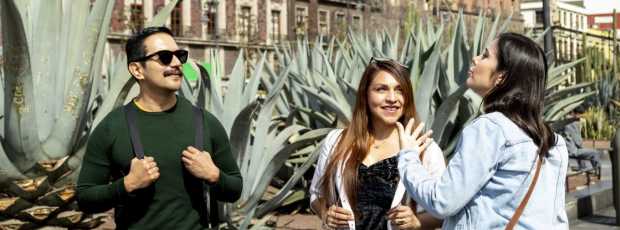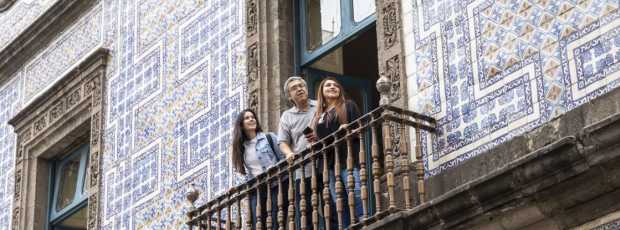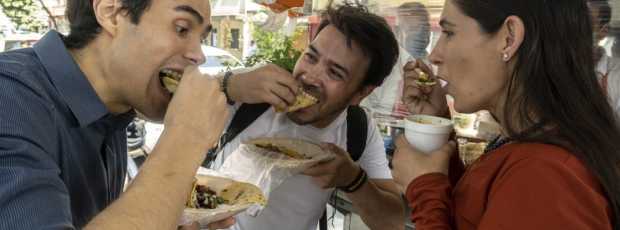Table Of Contents
- Starting Your Mexico City Adventure: The Heart of Everything
- Day One Morning: Where Ancient Meets Colonial
- Discovering Templo Mayor: Where Time Stands Still
- The National Palace: Diego Rivera's Revolutionary Vision
- Morning Coffee Break: Centro Histórico Traditions
- Afternoon in Chapultepec: The Heart of Mexican Culture
- National Museum of Anthropology: Mexico's Greatest Treasure
- Evening Stroll Through Roma Norte
- Dinner and Nightlife: Authentic Mexico City Flavors
- Day Two: Exploring Condesa and Coyoacán
- Breakfast in Condesa: Local Neighborhood Life
- Journey to Coyoacán: Frida's Neighborhood
- Casa Azul: Frida Kahlo's Sacred Space
- Lunch in Coyoacán: Traditional Mexican Flavors
- Torre Latino americana: Mexico City from Above
- Evening at Palacio de Bellas Artes
- Lucha Libre: Mexico City's Theatrical Sport
- Where to Stay: Centrally Located Options
- Transportation and Getting Around
- Safety Tips: How to Stay Safe
- Food Adventures: Beyond the Basics
- Must-See Attractions Summary
- Planning Your Mexico City Experiences
- Final Thoughts: The Soul of Mexico City
If you're planning 2 days in Mexico City, let me tell you what I'd show you if you were my dear friend visiting for the first time. I've lived in this sprawling, beautiful, chaotic city my entire life, and after four decades of wandering these streets, I know exactly where to take you to fall in love with Mexico City the way I did as a child.
![[IMAGE: A warm morning scene of Mexico City's skyline with the sun casting golden light over the urban landscape, showing the mix of colonial and modern architecture. Filename: mexico-city-golden-morning.jpg]]()
When people ask me about the perfect trip to Mexico City, I always start with this: forget everything you think you know about tourist guides. This isn't about checking boxes or rushing through must-see lists. This is about feeling the heartbeat of one of Latin America's most complex and beautiful capitals.
Starting Your Mexico City Adventure: The Heart of Everything
Your Mexico City start should always be in the Centro Histórico, where our story as a city truly begins. I remember my grandmother taking me here when I was seven, her weathered hand in mine as we stood before the Metropolitan Cathedral. "Mira, niña," she whispered, "this is where your ancestors prayed, where they built dreams on top of dreams."
![[IMAGE: The imposing facade of the Metropolitan Cathedral in Mexico City's historic center, with people gathering on the steps and pigeons flying overhead. Filename: metropolitan-cathedral-facade.jpg]]()
Istórico isn't just a neighborhood, it's a UNESCO World Heritage Site that holds 500 years of history in every cobblestone. When you step into the main square, officially called Plaza de la Constitución but known to everyone as the Zócalo, you're standing where the Aztecs once gathered, where conquistadors planted their flag, where my own great-grandfather sold newspapers during the Revolution.
![[IMAGE: An aerial view of the Zócalo with the massive Mexican flag waving in the center, surrounded by historic buildings and filled with people. Filename: zocalo-aerial-mexican-flag.jpg]]()
Day One Morning: Where Ancient Meets Colonial
I always tell visitors to start early in the historic center. The morning light hits the stunning architecture of the Metropolitan Cathedral in a way that makes you understand why this place has been sacred for centuries. The cathedral, one of the most iconic buildings in Latin America, sits directly on top of what was once the main temple of Tenochtitlan, the ancient city that the Aztecs built on water.
![[IMAGE: Early morning light streaming through the interior of the Metropolitan Cathedral, illuminating the ornate altars and creating dramatic shadows. Filename: cathedral-morning-light-interior.jpg]]()
Walking through these streets, you'll notice how the buildings lean slightly, they're slowly sinking into the soft lake bed that once supported the ancient Mesoamerican city. My architect friend Carlos always jokes that Mexico City is the only place where you can watch history in motion.
![[IMAGE: A narrow street in the historic center showing the slight lean of colonial buildings, with characteristic balconies and doorways. Filename: historic-leaning-buildings.jpg]]()
Looking for a private city experience in Mexico City?
Explore the city with a local who plans a private day just for you; no groups, no scripts.
Discovering Templo Mayor: Where Time Stands Still
A short walk from the cathedral brings you to Templo Mayor, the archaeological site that never fails to give me chills. This is where you'll truly understand why days in Mexico City can feel like traveling through time. The main temple of the Aztec empire lies here, partially excavated, showing you exactly how the Spanish built their city on top of ours.
![[IMAGE: The excavated ruins of Templo Mayor with modern Mexico City buildings rising behind it, showing the dramatic contrast between ancient and contemporary. Filename: templo-mayor-modern-contrast.jpg]]()
I've brought my children here countless times, watching their eyes widen as they realize they're standing where priests once climbed stone steps to honor their gods. The museum at Templo Mayor houses other artifacts that tell the story of pre-Hispanic culture in ways that textbooks never could.
![[IMAGE: Interior shot of the Templo Mayor museum showing ancient Aztec artifacts including stone sculptures and ceremonial objects in glass display cases. Filename: templo-mayor-museum-artifacts.jpg]]()
The National Palace: Diego Rivera's Revolutionary Vision
Next door to the cathedral stands the National Palace, where Diego Rivera's murals cover entire walls with the story of Mexico. I remember the first time I saw Rivera's "The History of Mexico", I was fifteen, on a school trip, and I stood there for an hour just absorbing every detail of his revolutionary vision.
![[IMAGE: Close-up of Diego Rivera's famous mural in the National Palace showing indigenous people, conquistadors, and revolutionary figures in vibrant colors. Filename: diego-rivera-national-palace-mural.jpg]]()
These murals aren't just art, they're Diego Rivera's love letter to our country, painted with such passion that you can feel his brushstrokes carrying the weight of centuries. The way he depicted pre-Hispanic culture alongside colonial and modern Mexico shows you exactly why Diego Rivera remains one of our most beloved artists.
![[IMAGE: Wide shot of visitors looking up at the massive Diego Rivera murals covering the stairwell walls of the National Palace. Filename: national-palace-mural-visitors.jpg]]()
Morning Coffee Break: Centro Histórico Traditions
By now, you'll need coffee, and I know exactly where to take you. There's a little café tucked into one of the historical centre's colonial houses where my family has been going for three generations. The owner, Doña Carmen, makes coffee the way my grandmother did, slow, strong, and served with stories.
![[IMAGE: A traditional Mexican coffee shop interior with vintage furniture, ceramic cups, and an elderly woman behind a wooden counter. Filename: traditional-coffee-shop-centro.jpg]]()
This is what I love about days in Mexico, the way everyday moments become memories. While you sip your café de olla, sweetened with cinnamon and piloncillo, you'll watch the city wake up around you. Street vendors setting up their stalls, office workers hurrying to their jobs, children in school uniforms holding their parents' hands.
![[IMAGE: A steaming cup of café de olla on a wooden table with cinnamon sticks and brown sugar, with the street scene visible through a window. Filename: cafe-de-olla-street-view.jpg]]()
What if your day in Mexico City was planned by someone who knows it — and you?
City Unscripted matches you with a local host who creates a private experience based on your interests, not a set route.
Afternoon in Chapultepec: The Heart of Mexican Culture
After lunch in the Centro, we head to Chapultepec Park, the green lung of Mexico City. Bosque de Chapultepec is more than just a park, it's where families come to breathe, where couples fall in love, and where children discover that trees can grow as tall as buildings.
![[IMAGE: Families enjoying a sunny afternoon in Chapultepec Park with tall trees, walking paths, and children playing. Filename: chapultepec-families-sunny-day.jpg]]()
I've been walking these paths since I could barely keep up with my older sister's longer stride. Chapultepec Park holds some of Mexico City's most incredible museums, including the National Museum of Anthropology, where you can spend three hours and feel like you've barely scratched the surface.
![[IMAGE: The distinctive modernist architecture of the National Museum of Anthropology with its iconic umbrella-like concrete canopy. Filename: anthropology-museum-architecture.jpg]]()
National Museum of Anthropology: Mexico's Greatest Treasure
The National Museum houses the most important collection of pre-Hispanic culture in the world. When I take friends here, I always start with the Aztec Hall, where the famous Sun Stone sits like a calendar carved by gods. This museum tells the story of every civilization that called Mexico home long before the Spanish arrived.
![[IMAGE: The famous Aztec Sun Stone displayed in the museum with dramatic lighting highlighting its intricate carved details. Filename: aztec-sun-stone-museum.jpg]]()
My favorite piece has always been the jade funeral mask of Pakal, the Maya king. There's something about looking into those jade eyes that connects you directly to the ancient ruins of Palenque, to a world that existed centuries before Columbus ever dreamed of crossing an ocean.
![[IMAGE: Close-up of an intricate jade funeral mask with detailed craftsmanship, displayed in a darkened museum case with spotlighting. Filename: jade-funeral-mask-pakal.jpg]]()
Evening Stroll Through Roma Norte
As the sun begins to set, we make our way to Roma Norte, the trendy neighborhood that perfectly captures modern Mexico City's creative spirit. This area, with its tree-lined streets and Art Deco houses, has become home to the city's best restaurants, art galleries, and coffee shops.
Roma Norte wasn't always this fashionable. I remember when my aunt lived here in the 1980s, after the earthquake, when many buildings were damaged and rents were cheap. Now it's where young artists, writers, and chefs come to reinvent Mexican culture for a new generation.
![[IMAGE: Young people sitting at outdoor tables at a trendy cafe in Roma Norte, with modern Mexican art visible on the walls. Filename: roma-norte-trendy-cafe-scene.jpg]]()
Tip
We match you with the right host, not just any guide.Want to experience the real Mexico City with someone who lives there?
A fully private experience, planned and led by a local host who tailors the day to you
Dinner and Nightlife: Authentic Mexico City Flavors
For dinner on your first night, I'll take you to try al pastor, the Lebanese-influenced taco that became as Mexican as mole. We'll head to a taquería where the pastor spins on a vertical spit, where the trompo master slices meat with theatrical flair, catching pineapple pieces mid-air.
This is food as performance art, food as cultural expression. When you bite into that perfect taco, meat, pineapple, onion, cilantro, salsa, you're tasting the story of Mexico City: indigenous corn tortillas holding Lebanese-inspired meat, topped with New World pineapple and chili.
![[IMAGE: Close-up of perfectly assembled al pastor tacos on a wooden plate with lime wedges and various salsas. Filename: perfect-al-pastor-tacos-close-up.jpg]]()
Day Two: Exploring Condesa and Coyoacán
Your second morning in Mexico City should start in La Condesa, Roma Norte's sister neighborhood. Colonia Condesa has a completely different energy, more relaxed, more residential, built around Parque México, a circular park that serves as the neighborhood's living room.
I love walking through La Condesa because it feels like a small town within the megacity. The houses here tell stories of Mexico City's golden age, when architects dreamed in curves and built neighborhoods that felt like European cities but with Mexican hearts.
![[IMAGE: Characteristic Art Deco building in Condesa with curved balconies and decorative elements, surrounded by jacaranda trees. Filename: condesa-art-deco-building.jpg]]()
Breakfast in Condesa: Local Neighborhood Life
We'll have breakfast at a corner café where the regulars know each other's names and the waitress remembers how you like your coffee. This is people watching at its finest, young professionals checking their phones, elderly couples sharing the newspaper, and children heading to school with their backpacks bouncing.
![[IMAGE: A cozy neighborhood café in Condesa with local regulars reading newspapers and chatting over coffee, warm morning light streaming in. Filename: condesa-neighborhood-cafe.jpg]]()
Ready to plan your perfect day in Mexico City?
Start your experienceJourney to Coyoacán: Frida's Neighborhood
After breakfast, we take the metro to Coyoacán neighborhood, where cobblestone streets and colonial houses create an atmosphere so different from central Mexico City that you might forget you're still in the same urban sprawl. This is where Frida Kahlo lived, loved, and painted.
![[IMAGE: Cobblestone streets of Coyoacán with colonial houses painted in bright colors and bougainvillea climbing the walls. Filename: coyoacan-cobblestone-colonial-houses.jpg]]()
Coyoacán neighborhood feels like a small town that got swallowed by the city but refused to change its character. Here, vendors sell fresh fruit in the main square, mariachi musicians practice in the shade, and the pace of life slows to something approaching human scale.
Casa Azul: Frida Kahlo's Sacred Space
The Frida Kahlo Museum, known as Casa Azul or the Blue House, is where Mexico's most famous artist lived her passionate, painful, brilliant life. Walking through these rooms where Frida Kahlo painted, where she loved Diego Rivera, where she suffered and created, feels like stepping into the pages of a diary.
![[IMAGE: The iconic cobalt blue exterior walls of Casa Azul with its distinctive architectural details and lush garden visible beyond the entrance. Filename: casa-azul-blue-exterior.jpg]]()
I've visited Casa Azul dozens of times, and every visit reveals something new. Maybe it's the way afternoon light falls across her studio, or the personal objects that show you how she lived: her dresses, her paint brushes, her bed where she painted while bedridden.
![[IMAGE: Interior of Frida Kahlo's bedroom studio showing her bed, easel, and personal belongings arranged as they were when she lived there. Filename: frida-studio-bedroom-interior.jpg]]()
The Frida Kahlo Museum isn't just about one artist, it's about understanding how Mexico City shapes creative souls, how this city of contrasts, of ancient and modern, of beauty and struggle, produces art that speaks to the world.
Lunch in Coyoacán: Traditional Mexican Flavors
For lunch, we'll eat at a restaurant that's been run by the same family for forty years, where the mole recipe is passed down like a family heirloom. This is where you'll taste real Mexican food, not the tourist version, but the food that grandmothers make, that requires hours of preparation and generations of knowledge.
![[IMAGE: A traditional Mexican family restaurant in Coyoacán with colorful papel picado decorations and a grandmother cooking at a large stove. Filename: traditional-family-restaurant-coyoacan.jpg]]()
Torre Latino americana: Mexico City from Above
After lunch, we head back to the center for a different perspective on Mexico City. The Torre Latino americana, once the tallest building in Latin America, offers views that help you understand the impossible scale of this city. From the observation deck, you can see how Mexico City spreads in every direction, a urban ocean that seems to touch the horizon.
![[IMAGE: Panoramic view of Mexico City from Torre Latinoamericana's observation deck, showing the vast urban sprawl extending to the mountains. Filename: torre-latina-city-panorama.jpg]]()
Standing up there, looking out over millions of lives unfolding simultaneously, I always think about how Mexico City is really thousands of small neighborhoods, each with its character, all connected by shared stories and history.
Evening at Palacio de Bellas Artes
As afternoon turns to evening, we visit Palacio de Bellas Artes, the marble palace that houses Mexico's finest art. The building itself is a work of art; its Art Nouveau exterior and Art Deco interior make it one of Mexico City's most beautiful iconic buildings.
![[IMAGE: The stunning white marble facade of Palacio de Bellas Artes with its distinctive domed architecture and sculptures. Filename: palacio-bellas-artes-facade.jpg]]()
Inside, more Diego Rivera murals await, along with works by José Clemente Orozco and David Alfaro Siqueiros. These art galleries tell the story of Mexican history through the eyes of artists who lived through revolution, who painted their dreams and nightmares with equal passion.
Lucha Libre: Mexico City's Theatrical Sport
For your final night, we're doing something uniquely Mexican: attending a lucha libre match. Lucha libre isn't just wrestling; it's theater, it's mythology, it's good versus evil played out in spandex and masks. Arena México, where we'll go, has been hosting lucha libre matches since 1956.
![[IMAGE: The vibrant atmosphere inside Arena México during a lucha libre match, with colorful masked wrestlers and an enthusiastic crowd. Filename: lucha-libre-arena-mexico-match.jpg]]()
Watching lucha libre is like watching Mexico City's soul in action, dramatic, colorful, full of passion, and humor. The crowd becomes part of the show, cheering for heroes, booing villains, and throwing paper cups when the referee makes bad calls.
Where to Stay: Centrally Located Options
Throughout your 2 days in Mexico City, you'll want to stay somewhere centrally located to make the most of your time. The historic center offers boutique hotels in converted colonial houses, while Roma Norte and La Condesa have modern accommodations with rooftop terrace spaces and swimming pool amenities.
![[IMAGE: A boutique hotel rooftop terrace in Roma Norte with city views, comfortable seating, and evening lighting. Filename: boutique-hotel-rooftop-terrace.jpg]]()
I always recommend staying in the adjacent neighborhoods to the center, you'll be close to major attractions but surrounded by authentic neighborhood life. You'll wake up to the sound of street vendors, fall asleep to the distant sound of mariachi music.
Transportation and Getting Around
Mexico City has an extensive metro system that connects all the amazing places we've visited. The metro is efficient, cheap, and an adventure in itself, each station tells a story, many decorated with art and archaeological site replicas.
For some destinations, like the floating islands of Xochimilco (perfect for a day trip if you have extra time), you'll want to take a taxi or rideshare. But most of your 2 days in Mexico City can be navigated on foot and by metro.
Safety Tips: How to Stay Safe
Like any major city, Mexico City requires basic urban awareness. Stay safe by keeping your valuables secure, staying in well-lit areas at night, and trusting your instincts. The neighborhoods we've explored, the historic center, Roma Norte, La Condesa, and Coyoacán, are generally safe for tourists who use common sense.
![[IMAGE: Well-lit evening street scene in Roma Norte with people walking safely on sidewalks past shops and restaurants. Filename: roma-norte-safe-evening-street.jpg]]()
Food Adventures: Beyond the Basics
Your dining options in Mexico City extend far beyond tacos. We have restaurants that blend traditional Mexican techniques with international influences, street food that represents regional cuisines from across Mexico, and markets where you can taste everything from grasshopper tacos to exotic tropical fruits.
![[IMAGE: A bustling Mexican market with colorful displays of tropical fruits, vegetables, and prepared foods. Filename: mexican-market-colorful-food-displays.jpg]]()
Must-See Attractions Summary
Must see attractions during 2 days in Mexico City include the UNESCO World Heritage Site of the historic center, Templo Mayor's archaeological site, Casa Azul where Frida Kahlo lived, Chapultepec Park with its incredible museums, and the vibrant neighborhoods of Roma Norte and La Condesa.
![[IMAGE: A collage-style image showing multiple iconic Mexico City landmarks including the cathedral, Casa Azul, and Chapultepec Castle. Filename: mexico-city-landmarks-collage.jpg]]()
Planning Your Mexico City Experiences
Every trip to Mexico City should include a mix of history, art, food, and neighborhood exploration. The beauty of days in Mexico is that you can customize your experience, spend more time in museums if you love art, or focus on street food if you're a culinary adventurer.
For those planning longer stays, you might want to explore our guide to 3 days in Mexico City, which includes additional neighborhoods and attractions.
Final Thoughts: The Soul of Mexico City
What makes Mexico City special isn't just its ancient ruins or stunning architecture, it's the way history lives alongside the present, the way pre-Hispanic culture influences contemporary art, the way every street corner holds stories.
![IMAGE: A sunset view over Mexico City showing the contrast between ancient pyramids in the distance and modern skyscrapers. Filename: mexico-city-sunset-ancient-modern.jpg]]()
During your 48 hours here, you'll visit amazing places, taste incredible food, and meet people whose families have called this city home for generations. You'll walk where Aztec emperors once walked, where revolutionary heroes plotted change, where artists like Diego Rivera and Frida Kahlo created art that still moves the world.
![[IMAGE: A street musician playing guitar on a Mexico City corner with colonial buildings in the background and people gathering to listen. Filename: street-musician-colonial-background.jpg]]()
Mexico City isn't just a destination, it's a living museum, a city where every neighborhood tells a different story, where every meal connects you to centuries of tradition, where every conversation reveals new layers of Mexican culture.
![[IMAGE: An elderly Mexican woman sharing stories with a young visitor over coffee in a traditional café setting. Filename: mexican-grandmother-storytelling-cafe.jpg]]()
When you leave after your 2 days in Mexico City, you'll carry with you not just photos and souvenirs, but stories. Stories of the vendors who sold you fresh fruit, of the mariachi singer who serenaded your table, of the grandmother who taught you the right way to eat a taco.
These are the Mexico City experiences that transform tourists into travelers, that turn a trip into a love affair with one of the world's greatest cities. And if you're anything like the thousands of visitors I've shared my city with over the years, you'll be planning your return before you even head to the airport.
Mexico City is waiting for you, with all its chaos and beauty, its ancient ruins and modern innovations, its street food and fine art. Come with an open heart, and leave with stories that will last a lifetime.
What if your day in Mexico City was planned by someone who knows it — and you?
City Unscripted matches you with a local host who creates a private experience based on your interests, not a set route.
Want to experience the real Mexico City with someone who lives there?
A fully private experience, planned and led by a local host who tailors the day to you











